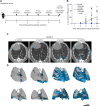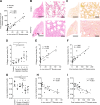Longitudinal microcomputed tomography detects onset and progression of pulmonary fibrosis in conditional Nedd4-2 deficient mice
- PMID: 39437758
- PMCID: PMC11684955
- DOI: 10.1152/ajplung.00280.2023
Longitudinal microcomputed tomography detects onset and progression of pulmonary fibrosis in conditional Nedd4-2 deficient mice
Abstract
Idiopathic pulmonary fibrosis (IPF) is a fatal lung disease, which is usually diagnosed late in advanced stages. Little is known about the subclinical development of IPF. We previously generated a mouse model with conditional Nedd4-2 deficiency (Nedd4-2-/-) that develops IPF-like lung disease. The aim of this study was to characterize the onset and progression of IPF-like lung disease in conditional Nedd4-2-/- mice by longitudinal micro-computed tomography (CT). In vivo micro-CT was performed longitudinally in control and conditional Nedd4-2-/- mice at 1, 2, 3, 4, and 5 mo after doxycycline induction. Furthermore, terminal in vivo micro-CT followed by pulmonary function testing and post mortem micro-CT was performed in age-matched mice. Micro-CT images were evaluated for pulmonary fibrosis using an adapted fibrosis scoring system. Histological assessment of lung collagen content was conducted as well. Micro-CT is sensitive to detect the onset and progression of pulmonary fibrosis in vivo and to quantify distinct radiological IPF-like features along disease development in conditional Nedd4-2-/- mice. Nonspecific interstitial alterations were detected from 3 mo, whereas key features such as honeycombing-like lesions were detected from 4 mo onward. Pulmonary function correlated well with in vivo (r = -0.738) and post mortem (r = -0.633) micro-CT fibrosis scores and collagen content. Longitudinal micro-CT enables in vivo monitoring of the onset and progression and detects radiological key features of IPF-like lung disease in conditional Nedd4-2-/- mice. Our data support micro-CT as a sensitive quantitative endpoint for the preclinical evaluation of novel antifibrotic strategies.NEW & NOTEWORTHY IPF diagnosis, particularly in early stages, remains challenging. In this study, micro-CT is used in conditional Nedd4-2-/- mice to closely monitor the onset and progression of progressive pulmonary fibrosis in vivo. Together with high-resolution post mortem micro-CT, this allowed us to track how nonspecific lung lesions develop into key IPF-like features. This approach offers a noninvasive method to monitor pulmonary fibrosis, providing a quantitative endpoint for the preclinical evaluation of novel antifibrotic strategies.
Keywords: IPF; Nedd4-2; animal model; idiopathic pulmonary fibrosis; micro-CT.
Conflict of interest statement
No conflicts of interest, financial or otherwise, are declared by the authors.
Figures






References
-
- Raghu G, Remy-Jardin M, Richeldi L, Thomson CC, Inoue Y, Johkoh T, , et al. . Idiopathic pulmonary fibrosis (an update) and progressive pulmonary fibrosis in adults: an official ATS/ERS/JRS/ALAT clinical practice guideline. Am J Respir Crit Care Med 205: e18–e47, 2022. doi:10.1164/rccm.202202-0399ST. - DOI - PMC - PubMed
MeSH terms
Substances
Grants and funding
LinkOut - more resources
Full Text Sources

